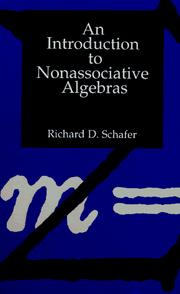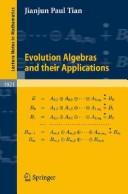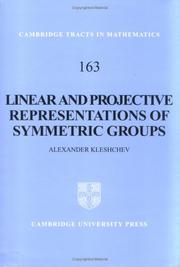| Listing 1 - 6 of 6 |
Sort by
|

ISBN: 1281766372 9786611766375 0080873340 0123745691 9780080873343 9780123745699 0126224501 9780126224504 0486688135 9780486688138 Year: 1966 Publisher: New York Academic Press
Abstract | Keywords | Export | Availability | Bookmark
 Loading...
Loading...Choose an application
- Reference Manager
- EndNote
- RefWorks (Direct export to RefWorks)
An introduction to nonassociative algebras
Nonassociative algebras. --- Alternative algebras. --- Algebras, Alternative --- Algebras, Non-associative --- Algebras, Nonassociative --- Non-associative algebras --- Nonassociative algebras --- Algebra, Abstract --- Algebras, Linear
Book
ISBN: 3031393341 9783031393341 Year: 2023 Publisher: Cham : Springer,
Abstract | Keywords | Export | Availability | Bookmark
 Loading...
Loading...Choose an application
- Reference Manager
- EndNote
- RefWorks (Direct export to RefWorks)
This book gathers invited, peer-reviewed works presented at the 2021 edition of the Classical and Constructive Nonassociative Algebraic Structures: Foundations and Applications—CaCNAS: FA 2021, virtually held from June 30 to July 2, 2021, in dedication to the memory of Professor Nebojša Stevanović (1962-2009). The papers cover new trends in the field, focusing on the growing development of applications in other disciplines. These aspects interplay in the same cadence, promoting interactions between theory and applications, and between nonassociative algebraic structures and various fields in pure and applied mathematics. In this volume, the reader will find novel studies on topics such as left almost algebras, logical algebras, groupoids and their generalizations, algebraic geometry and its relations with quiver algebras, enumerative combinatorics, representation theory, fuzzy logic and foundation theory, fuzzy algebraic structures, group amalgams, computer-aided development and transformation of the theory of nonassociative algebraic structures, and applications within natural sciences and engineering. Researchers and graduate students in algebraic structures and their applications can hugely benefit from this book, which can also interest any researcher exploring multi-disciplinarity and complexity in the scientific realm.
Proof theory. --- Nonassociative rings. --- Algebra, Homological. --- Topological groups. --- Lie groups. --- Differential equations. --- Proof Theory and Constructive Mathematics. --- Non-associative Rings and Algebras. --- Category Theory, Homological Algebra. --- Topological Groups and Lie Groups. --- Differential Equations. --- Nonassociative algebras. --- Àlgebres no associatives
Book
ISBN: 3110526697 3110527499 9783110527490 9783110526691 Year: 2018 Publisher: Berlin Boston
Abstract | Keywords | Export | Availability | Bookmark
 Loading...
Loading...Choose an application
- Reference Manager
- EndNote
- RefWorks (Direct export to RefWorks)
With applications in quantum field theory, general relativity and elementary particle physics, this four-volume work studies the invariance of differential operators under Lie algebras, quantum groups and superalgebras. This third volume covers supersymmetry, including detailed coverage of conformal supersymmetry in four and some higher dimensions, furthermore quantum superalgebras are also considered. Contents Lie superalgebras Conformal supersymmetry in 4D Examples of conformal supersymmetry for D › 4 Quantum superalgebras
Lie algebras. --- Lie groups. --- Differential invariants. --- Differential operators. --- Quantum groups. --- Superalgebras. --- Nonassociative algebras --- Enveloping algebras, Quantized --- Function algebras, Quantized --- Groups, Quantum --- Quantized enveloping algebras --- Quantized function algebras --- Quantum algebras --- Group theory --- Mathematical physics --- Quantum field theory --- Operators, Differential --- Differential equations --- Operator theory --- Invariants, Differential --- Continuous groups --- Groups, Lie --- Lie algebras --- Symmetric spaces --- Topological groups --- Algebras, Lie --- Algebra, Abstract --- Algebras, Linear --- Lie groups
Book
ISBN: 3031320093 3031320085 Year: 2023 Publisher: Cham, Switzerland : Springer,
Abstract | Keywords | Export | Availability | Bookmark
 Loading...
Loading...Choose an application
- Reference Manager
- EndNote
- RefWorks (Direct export to RefWorks)
The goal of the 2019 conference on Stochastic Processes and Algebraic Structures held in SPAS2019, Västerås, Sweden, from September 30th to October 2nd 2019 was to showcase the frontiers of research in several important topics of mathematics, mathematical statistics, and its applications. The conference has been organized along the following tracks: 1. Stochastic processes and modern statistical methods in theory and practice, 2. Engineering Mathematics, 3. Algebraic Structures and applications. This book highlights the latest advances in algebraic structures and applications focused on mathematical notions, methods, structures, concepts, problems, algorithms, and computational methods for the natural sciences, engineering, and modern technology. In particular, the book features mathematical methods and models from non-commutative and non-associative algebras and rings associated to generalizations of differential calculus, quantum deformations of algebras, Lie algebras, Lie superalgebras, color Lie algebras, Hom-algebras and their n-ary generalizations, semi-groups and group algebras, non-commutative and non-associative algebras and computational algebra interplay with q-special functions and q-analysis, topology, dynamical systems, representation theory, operator theory and functional analysis, applications of algebraic structures in coding theory, information analysis, geometry and probability theory. The book gathers selected, high-quality contributed chapters from several large research communities working on modern algebraic structures and their applications. The chapters cover both theory and applications, and are illustrated with a wealth of ideas, theorems, notions, proofs, examples, open problems, and results on the interplay of algebraic structures with other parts of Mathematics. The applications help readers grasp the material, and encourage them to develop new mathematical methods and concepts in their future research. Presenting new methods and results, reviews of cutting-edge research, open problems, and directions for future research, will serve as a source of inspiration for a broad range of researchers and students. .
Universal algebra. --- Commutative algebra. --- Commutative rings. --- Nonassociative rings. --- Operator theory. --- Stochastic processes. --- Harmonic analysis. --- General Algebraic Systems. --- Commutative Rings and Algebras. --- Non-associative Rings and Algebras. --- Operator Theory. --- Stochastic Processes. --- Abstract Harmonic Analysis. --- Nonassociative algebras. --- Noncommutative algebras. --- Processos estocàstics --- Àlgebres no commutatives --- Àlgebres no associatives

ISBN: 3540742832 3540742840 Year: 2008 Publisher: Berlin, Germany ; New York, New York : Springer,
Abstract | Keywords | Export | Availability | Bookmark
 Loading...
Loading...Choose an application
- Reference Manager
- EndNote
- RefWorks (Direct export to RefWorks)
Behind genetics and Markov chains, there is an intrinsic algebraic structure. It is defined as a type of new algebra: as evolution algebra. This concept lies between algebras and dynamical systems. Algebraically, evolution algebras are non-associative Banach algebras; dynamically, they represent discrete dynamical systems. Evolution algebras have many connections with other mathematical fields including graph theory, group theory, stochastic processes, dynamical systems, knot theory, 3-manifolds, and the study of the Ihara-Selberg zeta function. In this volume the foundation of evolution algebra theory and applications in non-Mendelian genetics and Markov chains is developed, with pointers to some further research topics.
Banach algebras --- Genetic algebras --- Nonassociative algebras --- Markov processes --- Phytophthora infestans --- Stochastic processes --- Algebra --- Calculus --- Mathematics --- Physical Sciences & Mathematics --- Genetics --- Banach algebras. --- Genetic algebras. --- Nonassociative algebras. --- Markov processes. --- Stochastic processes. --- Algebra. --- Genetics. --- Random processes --- Botrytis fallax --- Botrytis infestanus --- Botrytis solani --- Peronospora fintelmannii --- Peronospora infestans --- Peronospora trifurcata --- Phytophthora thalictri --- Potato late blight agent --- Potato late blight fungus --- Analysis, Markov --- Chains, Markov --- Markoff processes --- Markov analysis --- Markov chains --- Markov models --- Models, Markov --- Processes, Markov --- Algebras, Non-associative --- Algebras, Nonassociative --- Non-associative algebras --- Algebras, Genetic --- Algebras, Banach --- Banach rings --- Metric rings --- Normed rings --- Mathematics. --- Nonassociative rings. --- Rings (Algebra). --- Probabilities. --- Biomathematics. --- General Algebraic Systems. --- Non-associative Rings and Algebras. --- Probability Theory and Stochastic Processes. --- Mathematical and Computational Biology. --- Mathematical analysis --- Probability --- Statistical inference --- Combinations --- Chance --- Least squares --- Mathematical statistics --- Risk --- Biology --- Algebraic rings --- Ring theory --- Algebraic fields --- Rings (Algebra) --- Math --- Science --- Probabilities --- Phytophthora --- Algebra, Abstract --- Algebras, Linear --- Biomathematics --- Banach spaces --- Topological algebras --- Distribution (Probability theory. --- Distribution functions --- Frequency distribution --- Characteristic functions

ISBN: 9780521837033 9780511542800 9781107471641 0511125747 9780511125744 0511542801 0521837030 1107139813 9786611836696 1281836699 051118137X 9786610415755 0511198078 0511331312 0511124880 Year: 2017 Volume: 163 Publisher: Cambridge: Cambridge university press,
Abstract | Keywords | Export | Availability | Bookmark
 Loading...
Loading...Choose an application
- Reference Manager
- EndNote
- RefWorks (Direct export to RefWorks)
The representation theory of symmetric groups is one of the most beautiful, popular and important parts of algebra, with many deep relations to other areas of mathematics such as combinatories, Lie theory and algebraic geometry. Kleshchev describes a new approach to the subject, based on the recent work of Lascoux, Leclerc, Thibon, Ariki, Grojnowski and Brundan, as well as his own. Much of this work has previously appeared only in the research literature. However to make it accessible to graduate students, the theory is developed from scratch, the only prerequisite being a standard course in abstract algebra. For the sake of transparency, Kleshchev concentrates on symmetric and spin-symmetric groups, though methods he develops are quite general and apply to a number of related objects. In sum, this unique book will be welcomed by graduate students and researchers as a modern account of the subject.
Linear algebraic groups. --- Representations of groups. --- Algebras, Linear. --- Geometry, Projective. --- Symmetry groups. --- Groups, Symmetry --- Symmetric groups --- Crystallography, Mathematical --- Quantum theory --- Representations of groups --- Projective geometry --- Geometry, Modern --- Linear algebra --- Algebra, Universal --- Generalized spaces --- Mathematical analysis --- Calculus of operations --- Line geometry --- Topology --- Group representation (Mathematics) --- Groups, Representation theory of --- Group theory --- Algebraic groups, Linear --- Geometry, Algebraic --- Algebraic varieties --- Modular representations of groups. --- Hecke algebras. --- Superalgebras. --- Nonassociative algebras --- Algebras, Hecke --- Group algebras
| Listing 1 - 6 of 6 |
Sort by
|

 Search
Search Feedback
Feedback About UniCat
About UniCat  Help
Help News
News